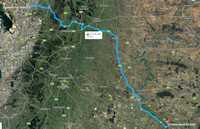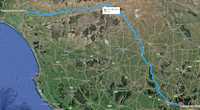Long Distance Rides
Long rides are different. The effects of fatigue, sun, cold, and rain, are magnified. But endurance rides mean we don’t have the option to stop and camp until things improve. We need a survival plan if things go wrong. Just riding to the next town may mean another 100km, so on an all-night ride we need to carry something which will let us stop and stay warm. That means more gear that we’d carry for a day ride. But food and gear means more weight, which chews up energy. Panniers add wind resistance. There are brilliant lightweight bivvy bags and frame bags for biking, but they are not cheap.
Each long ride has its own issues that need to be covered, depending on the distance and season, etc.
This is my game plan for an upcoming long ride from Adelaide to Melbourne. I hope to get away with only a short 90 minute sleep, mid ride.
Route Safety
The shortest route is about 760km. Valda Unthank did it in 33.75 hours in 1938, but I'm not that fast, or as young as her! And although now all bitumen, it’s a dangerous route for bikes, especially for cyclists who are very tired after 30 hours or more on the move. So the first step is to devise a route which is safer. There are three feasible non-stop routes.
All involve taking the back road from Elizabeth to Tailem Bend. (120km)
At Tailem Bend (at dawn) I can either take the Duke's Highway, or the road to Pinnaroo. I intend to take the Duke's, but if there is a strong south wind, I'll head east to Pinnaroo.
The second decision point is at Keith. I intend to leave the highway there and head to Naracoorte. This will allow me to go south of the Grampians via Dunkeld, and head towards Ballarat via Skipton. I'll turn off before Ballarat and take the old Melbourne Road to Ballan and then through Eynesbury to Footscray. (About 820km)
If the wind is inviting me to head east sooner rather than later, I can continue from Keith to Bordertown, and leave the highway there, just before dusk. This involves going in a southerly loop to Horsham via Frances and Goroke, and then looping north of the Western Highway from Horsham to Ballarat. Again, I will head to Ballan. (Around 800km)
If I end up taking the Pinaroo road, I need to go via Patchewollock and Sea Lake, and head for Bendigo. Before Bendigo, I can turn off at Bridgwater on Loddon, and head down through Maldon and Daylesford, to Ballan. (About 860km) Varying this by going through Donald and St Arnaud probably has less traffic, and is almost exactly the same distance. (I've ridden parts of this before, so it would be a good move.)
Ballan to Federation Square
Timing
Timing is important. I will arrive at Tailem Bend at dawn to avoid being on the Duke's in the dark. Its overtaking lanes and the wide median strips make it a surprisingly pleasant ride, but night riding is asking for trouble, given the amount of traffic it can carry.
Visibility
For visibility on this trip I will run a daylight flasher front and rear. I have sufficient lighting for a full night (plus a fall back spare front and back) and have battery packs to recharge my main night lights during the day. These will also cover my GPS, which lasts around 30 hours, and my phone.
I also wear a high vis reflective vest at night, and reflective ankle straps. In heavier traffic, or if it is raining, I will also turn on the taillight on my helmet.
Saving Time
A single photo is worth 300 metres, at least. A hamburger may take 20 minutes from ordering to eating, if not more. That's 6 or 7 kilometres. It's easy to lose 20 minutes to a "quick" stop without noticing. I use the following strategies to minimise time loss.
Know where to get water: Google Maps and Street View, and the National Public Toilet Map, are your friends.
Once I leave Naracoorte, or Bordertown, it's likely nothing will be open until dawn. (The Frances pub might still be open when I get there.) Back roads mean safety, but they also mean nothing is open at night.
Check to see if the town toilets are open all night. These are the best bet for water. In country towns some of the public toilets still have outside taps— but service stations increasingly tend not to have them. I empty my bidons (into me) while riding before I stop, so I am only taking time to fill up. I have a small cup which allows me to navigate shallow basins that won't let a bidon under the tap. I also carry an extra 1.25 litre bottle (at least) if I have not used a water point in the past. There's nothing worse than being thirsty at 2am in a town where you can't find water. Country folk don't tend to shoot first, but there's no point in asking for trouble. The point is this: if you don't know where it is, it can take half an hour to find a tap! And that tap may be owned by a big dog.
I seek to avoid shops; they waste time. So I have some high protein and high calorie food on the bike, so that I can simply keep rolling. (Dark Chocolate, a few muesli bars, and unsalted peanuts. I sometimes shove in an apple or a few sweet biscuits) I will buy the three main meals in the day, but take whatever's hot and on display, which usually means pies, so there is no waiting.
Food, phone and cameras work best if they are in a bar bag, or a jersey pocket; you can get to them without opening up the main bag, while you are straddling the bike, or even while moving.
There's one other thing that really uses up time: getting lost. I'll have all three routes saved on my phone as a gpx files. Back roads in the country sometimes have interesting signage, as do some country towns.
Heat and Cold
An hour at 8 or 9 degrees riding home to a shower on a winter's night, is very different to ten hours at 8 degrees— let alone 5 degrees plus wind-chill. Understand that if you have a 10kmh head wind you will be sitting in a 30kmh, 5 degree wind, for all of that time. It is painful, and more importantly, it is energy sapping. And that's before the rain.
Summer riding is warmer, but note that in February this year, on a 41 degree day, I had spent the previous evening riding at 11 degrees.
I will carry:
• Wetsuit style neoprene booties (great when cold, imperative in rain)
• Winter weight leggings
• Shy shorts over my knicks
• Long sleeve riding shirt
• Winter sleeveless gilet – I mean European winter weight. This is my main core protection. I find it works better than a base layer; base layers very soon stink, and are over rated in my opinion.
• Winter long sleeve jersey
• Wind-stopper fabric, water resistant, jacket
• Full water proof jacket — this is necessary for heavier and longer rain, but not good for cold weather. These things make you smell like a bottle of ammonia that's gone off! Don't believe what they say about breathable Gore-Tex. Ride for a few hours in one of these and you will be sopping wet inside, although passably warm. Undo the zip, and the pong will nearly knock you over!
• Balaclava
• Face mask— this sits under my glasses and goes down to the chin. It covers the face gap in the balaclava and makes a big difference on a really cold night.
• Full finger under-gloves
I mix and match the layers to suit the conditions.
I'll have a sleeping mat and a reflective blanket in case I have to bail out during the night.
With my food and extra litre of water, and spare lights, this will come in at around 4.5 kilos and fit nicely in a rack top bag. The rack top bag is especially helpful in head winds because of the lower wind resistance compared to panniers.
Training
I've been riding my normal 200km weekly commute.
I did 315km for the January TDU, 643 in February (to Blinman), 264km to Sedan (March 24), and 417km on April 2 for the Coast to Coast. The ride is Easter Monday (late) which is April 17.
Fatigue
It is quite easy to fall asleep riding a bike. My answer to drowsiness is to get off and walk/jog alongside the bike, then ride singing loudly. A 90 minute nap (a single sleep cycle) also works a treat, but it's at the cost of 30 kilometres, or more. As in a car, trying to tough out sleepiness is to plan your own funeral while you are asleep.
The key to fatigue, more generally, is not to ride to a speed. Speed is already largely defined for us by the surface, wind, geography, and our own fitness. Putting in extra energy for speed only works for shorter rides and will mean burning out on a long ride like this.
What works for longer distances in not wasting time (as noted above) and cadence. Pedal at a comfortable speed. Use the gears to keep pedalling smoothly. Move on and off the saddle regularly. Change the position of hands and wrists. Flex the back and shoulders. Keep the circulation happening in your feet— they will swell over time so don't have shoes to snug. Knead out any crampy grumbles immediately. All this keeps the body functioning.
Trickle feed water and calories. This helps not to "lose your legs."
Once I make it to Federation Square, it's only 120km back out to Ballarat, where I am staying. I may just take a proper sleep before that bit!






